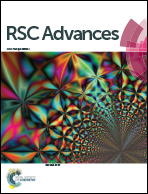Ultrafast conversion of carcinogenic 4-nitrophenol into 4-aminophenol in the dark catalyzed by surface interaction on BiPO4/g-C3N4 nanostructures in the presence of NaBH4†
Abstract
The heterogeneous catalytic conversion of pollutants into useful industrial compounds is a two-goals at once process, which is highly recommended from the environmental, economic, and industrial points of view. In this regard, design materials with high conversion ability for a specific application is required to achieve such a goal. Herein, the synthesis conditions for the fabrication of BiPO4 nanorod bundles supported on g-C3N4 nanosheets as heterojunction composites was achieved using a facile ex situ chemical deposition for the reductive conversion of carcinogenic 4-nitrophenol (4-NP) into 4-aminophenol (4-AP). To better understand the mechanistic reduction pathways, BiPO4/g-C3N4 composites with varying ratios where obtained. The morphology and structure of BiPO4/g-C3N4 composites were checked using several methods: XRD, FE-SEM, HRTEM, XPS, and FT-IR, and it was found that hexagonal phase BiPO4 nanorod bundles were randomly distributed on the g-C3N4 nanosheets. Overall, the reduction ability of BiPO4/g-C3N4 composites was far better than bare BiPO4 and g-C3N4. A total reductive conversion of 4-NP at a concentration of 10 mg L−1 into 4-AP was found with 50% BiPO4/g-C3N4 composite within only one minute of reaction. Moreover, the presence of reducing agent (NaBH4) enhanced the kinetic rate constant up to 2.914 min−1 using 50% BiPO4/g-C3N4, which was much faster than bare BiPO4 (0.052 min−1) or g-C3N4 (0.004 min−1). The effects of some operating parameters including the initial concentration of 4-NP and catalyst dosage were also evaluated during the experiments. BiPO4/g-C3N4 showed great stability and recyclability, wherein, the catalytic reduction efficiency remains the same after five runs. A plausible 4-NP reduction mechanism was discussed. The high catalytic activity with the good stability of BiPO4/g-C3N4 make it a potential candidate for the reduction of nitroaromatic compounds in real wastewaters.



 Please wait while we load your content...
Please wait while we load your content...